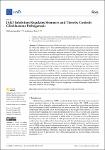JAK3 Inhibition Regulates Stemness and Thereby Controls Glioblastoma Pathogenesis
| dc.contributor.author | Smedley, W | |
| dc.contributor.author | Patra, A | |
| dc.date.accessioned | 2023-11-28T13:03:32Z | |
| dc.date.available | 2023-11-28T13:03:32Z | |
| dc.date.issued | 2023-10-30 | |
| dc.identifier.issn | 2073-4409 | |
| dc.identifier.issn | 2073-4409 | |
| dc.identifier.other | ARTN 2547 | |
| dc.identifier.uri | https://pearl.plymouth.ac.uk/handle/10026.1/21731 | |
| dc.description.abstract |
Glioblastoma multiforme (GBM) is the most deadly brain tumor, effective treatment options for which still remain elusive. The current treatment procedure of maximal resection followed by chemotherapy has proved to be grossly insufficient to prevent disease progression and death. Despite best efforts, the maximum survival post-diagnosis is a mere 1.5 years. Therefore, there is a huge unmet clinical need to find effective therapeutic procedures to prevent the pathogenesis and relapse of GBM. Small-molecule inhibitors of signaling pathways are an attractive option to prevent various types of tumors. However, no effective small-molecule inhibitors have been successful against GBM in clinical trials. Various signaling pathways are altered and an array of signaling molecules, transcription factors (TFs), and epigenetic modifying factors have been implicated in the pathogenesis of GBM. JAK-STAT pathway alteration is an important contributor to GBM pathogenesis and relapse. Many small-molecule inhibitors of JAKs, or STAT TFs, especially JAK2 and STAT3, have been assessed for their anti-tumor activity in GBM. However, no definitive success so far has been achieved. Herein, by using two small-molecule inhibitors of JAK3, we show that they are quite effective in inhibiting GBM cell proliferation and neurosphere formation, downregulating their stemness character, and inducing differentiation into neuronal origin cells. The effect of a single treatment with the drugs, both in a serum-containing differentiation medium and in a proliferation medium containing EGF and FGF, was really strong in limiting GBM cell growth, suggesting a potential therapeutic application for these JAK inhibitors in GBM therapy. | |
| dc.format.extent | 2547-2547 | |
| dc.format.medium | Electronic | |
| dc.language | en | |
| dc.publisher | MDPI AG | |
| dc.subject | glioblastoma | |
| dc.subject | JAK | |
| dc.subject | differentiation | |
| dc.subject | neurosphere and tumor therapy | |
| dc.title | JAK3 Inhibition Regulates Stemness and Thereby Controls Glioblastoma Pathogenesis | |
| dc.type | journal-article | |
| dc.type | Article | |
| plymouth.author-url | https://www.ncbi.nlm.nih.gov/pubmed/37947625 | |
| plymouth.issue | 21 | |
| plymouth.volume | 12 | |
| plymouth.publication-status | Published online | |
| plymouth.journal | Cells | |
| dc.identifier.doi | 10.3390/cells12212547 | |
| plymouth.organisational-group | |Plymouth | |
| plymouth.organisational-group | |Plymouth|Faculty of Health | |
| plymouth.organisational-group | |Plymouth|REF 2021 Researchers by UoA | |
| plymouth.organisational-group | |Plymouth|Users by role | |
| plymouth.organisational-group | |Plymouth|Users by role|Academics | |
| plymouth.organisational-group | |Plymouth|REF 2021 Researchers by UoA|UoA01 Clinical Medicine | |
| plymouth.organisational-group | |Plymouth|Faculty of Health|Peninsula Medical School | |
| plymouth.organisational-group | |Plymouth|REF 2028 Researchers by UoA | |
| plymouth.organisational-group | |Plymouth|REF 2028 Researchers by UoA|UoA01 Clinical Medicine | |
| dc.publisher.place | Switzerland | |
| dcterms.dateAccepted | 2023-10-26 | |
| dc.date.updated | 2023-11-28T13:03:23Z | |
| dc.rights.embargodate | 2023-11-30 | |
| dc.identifier.eissn | 2073-4409 | |
| rioxxterms.versionofrecord | 10.3390/cells12212547 |


